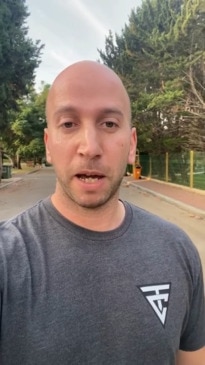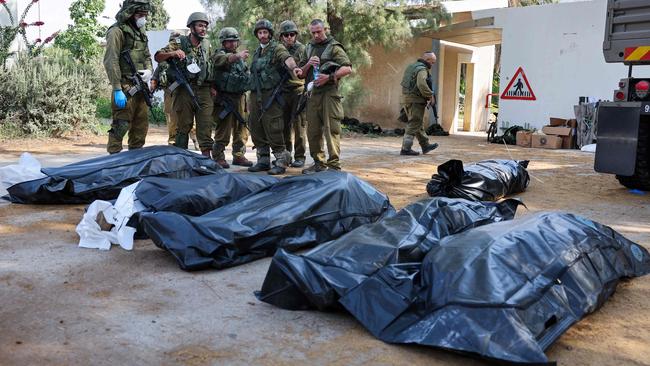Israel at war: Hardened soldiers broke down and cried at barbaric massacre of harmless babies
The scene before the Israeli soldiers at Kfar Aza was so depraved, so awful, these hardened men broke down and cried, forced to console each other | Warning: Graphic content

The worst of it was the babies.
When Israeli soldiers finally secured Kfar Aza, the small kibbutz closest to the Gaza perimeter fence, they had already witnessed atrocities and wilful mass murders unleashed by Hamas terrorists across 22 border villages in southern Israel.
Yet the scene before them at Kfar Aza was so depraved, so awful, these hardened men broke down and cried, forced to console each other.

At each house, there was sickening barbarity.
Elderly women had been told to hand over their phones, laptops and money, then covered in petrol and burned alive. It was horrific.
Yet nothing was more terrible than what was done to the babies.
Babies were found with their bodies in their cots and their severed heads placed separately on the floor in some kind of macabre power signal. In images taken days later, a small infant dress was still carefully laid out at the end of one cot, but smeared in blood. On another small bed, a baby’s bottle was difficult to see among the blood-soaked sheets.
Israeli soldiers found 40 of the youngest defenceless victims, many of them gruesomely beheaded. The tally of death in the village of 750 people is unclear but soldiers there said they found between 100 and 150 bodies.
Women were the target of a particular hatred. Pregnant women were tortured then beheaded, Israeli soldiers said.
“When Hamas came here, they cut the heads of women, they cut the heads of children,” Major David Ben Zion, 37, told a group of international journalists, making a chopping motion towards his neck. “We saw dead babies, girls.”

Most families were in deep sleep, in the middle of the Sabbath. Many Israeli soldiers had gone home for the weekend when the homemade paraglider with armed gunmen landed at the Kfar Aza kibbutz on Saturday.
Their first victim was not the local security but a 90-year-old woman sitting on her porch watching the sunrise who witnessed the aerial gunmen arrive about 6.30am.
Shaylee Atary was also awake in Kfar Aza, feeding her month-old baby daughter when she heard an explosion, but thought it was part of the “regular” fighting that often occurs across the Gaza Strip. Then she heard Arabic men calling “Come, come” and the shootings began.
Within seconds, Hamas soldiers opened her bedroom window and put their hand inside. Atary’s husband, filmmaker Yahav Winner, quickly signalled her to take baby Shaya away while he distracted the men.

Atary told American broadcaster PBS she ran to the back behind bushes and hid inside a shed behind a washing machine, putting a sand bucket over the baby to protect her further.
The baby was crying and fearing discovery, Atary ran to neighbours, who saw her on their security camera and let her into their safe room.
She said every time Shaya cried, the shooting and attacks on the safe room doubled “because it felt like – it’s like a prize to kill that baby”. She was not wrong.
Atary would spend 27 hours in the safe room, which the attackers tried to set on fire repeatedly, before being rescued. Baby Shaya, who had not had any water, was so dehydrated she was crying without tears. Atary’s husband is one of scores of people from the kibbutz still missing.

While the attackers roamed freely around Kfar Aza for more than a day on a murderous spree, other terrorists who streamed through the breaches of the Gaza perimeter went further south, spreading mayhem and targeting another kibbutz.
Two groups of Hamas terrorists surrounded the Supernova festival, cutting off the main road escape route and mowing down and killing 260 fleeing terrified festival-goers.
On the road, a small peloton of young cyclists from the Negev cycling club was in the wrong place as terrorists roared past them going deeper into Israeli territory, towards Sderot, and firing as they went.
In Sderot, the Hamas terrorists held the local police station for nearly 24 hours. Itai Cohen, 15, was hit by shrapnel in the eye and was lucky not to bleed to death, his family releasing a picture of their son drenched in blood.

The Hamas attackers were primed to attack the largest kibbutz in the area, Be’eri, a cultural hub of art galleries and printing works 8km south of Kfar Azar. There, 108 bodies – 10 per cent of the population – have been found, including Sydney-born grandmother Galit Carbone, 66, who had worked in the town as a librarian. She was found murdered outside her house.
The terrorists here tortured people, who begged for mercy before being executed. Homes were torched, burning occupants alive. We know this because the terrorists filmed themselves doing it. One militant with a film crew described the attacks on camera as the terrorists acted behind him, live-streaming the shocking scenes to an audience inside the Gaza Strip. Video grabs have been uploaded on to Arabic social media sites with hashtags of “Kibbutz_Be’eri”.
Be’eri resident Uri Ben Tzvi told Haaretz “I was like Anne Frank” as he survived by hiding down a corridor that had been camouflaged by a closet-looking door. “It was a pogrom.’’
Hamas used social media to devastating effort, magnifying their savagery for maximum physiological impact.

Adi Bayder checked up on her grandmother who lived in the southern kibbutz of Nir Oz by looking on her Facebook page only to discover the most harrowing scene: footage of her grandmother’s death.
“The entire floor, covered in blood, my grandma lying there,” Adi told Israeli TV. “The terrorist just took her private phone, filmed her, and uploaded it to her private Facebook. That’s how we found out.’’
Now the shock of the weekend attacks is turning to the fiercest of anger. Back in Kfar Azar, Major General Itai Verve warned any militants still in the area: “They aren’t warriors, this wasn’t a war, this was a criminal terrorist attack. We will fight hard until … we hit the last one.”








To join the conversation, please log in. Don't have an account? Register
Join the conversation, you are commenting as Logout